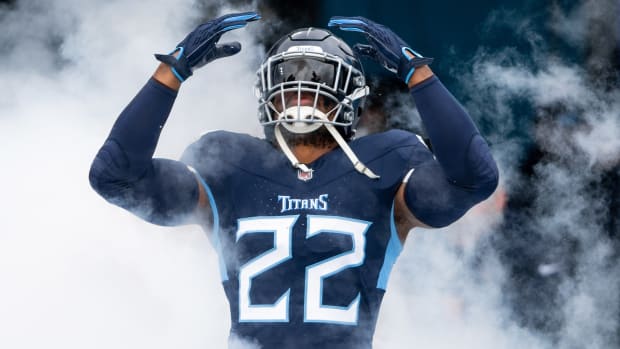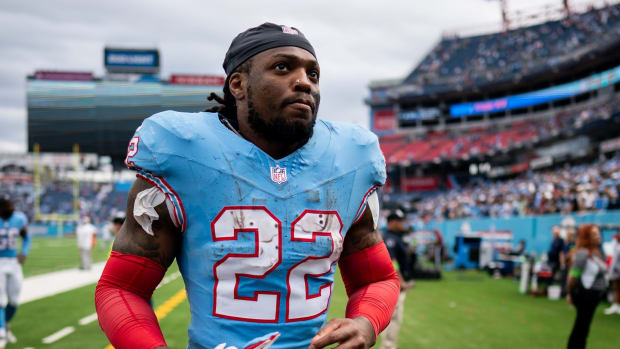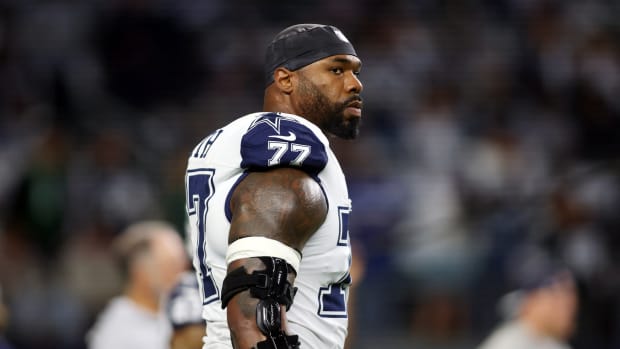Landry's Peak Performance Well-Timed
NASHVILLE – Think of the NFL’s top pass rushers as mountain climbers.
Every snap is like an ascent toward a distant peak, the faraway goal of reaching the quarterback.
It’s an impressive enough achievement just to get close, to breathe in the rare air that – on the football field -- comes with pressuring the quarterback. But there’s nothing quite like a quarterback sack, a pass-rusher’s version of planting his flag on the summit.
Often in previous years, Tennessee Titans outside linebacker Harold Landry did a lot of summit circling. This year, he has planted that flag – time after time after time.
Landry’s 6.5 sacks through six games are tied for third in the NFL, trailing only Cleveland’s Myles Garrett (8.0) and Pittsburgh’s T.J. Watt (7.0). In addition, Landry already has produced more sacks in his fourth year than he did in two of his previous three.
The ability to put that finishing touch on his rushes couldn’t be coming at a better time. The Titans’ second-round pick in 2018 is in the fourth and final year of his contract, meaning Landry – who is currently on pace for 18 sacks in 17 games – should be cashing in big-time on his next deal.
Don’t believe it?
Look at the facts: Edge rushers – either defensive ends or outside linebackers – accounted for four of the NFL’s 10 biggest free-agent deals during the past offseason, and nine of the top 30, per Spotrac.com.
That group includes Landry’s teammate, Bud Dupree, who signed a five-year, $82.5 million deal with the Titans despite the fact he was rehabilitating from ACL surgery. Dupree was coming off an eight-sack season in 2020 and averaged 6.6 sacks over six years. There was also defensive end Trey Hendrickson, who – after posting 13.5 sacks in 2020 – signed a four-year, $60 million deal in Cincinnati.
Quarterback pressures and hurries are swell, in other words, but sacks pay off come contract time.
“Pressures are great because when you say the word pressure, it means you’re affecting the quarterback in some way, shape or form,” Titans outside linebackers coach Ryan Crow said. “But the sacks are the ones that show up in the stat book, right? Those are the things that you want. Those are opportunities that are hard to come by. So, we’re constantly talking about it, working on it and finding ways to get (the quarterback) down to the ground.”
It’s not as if Landry came out of nowhere this year in terms of getting after the quarterback.
In 2019, for instance, his nine sacks were tied for 22nd in the league. In 2020, he posted 18 quarterback hurries (fifth in the NFL) and 34 pressures (14th).
But Landry never has produced at the level he has this year. He’s coming off his second straight two-sack game, something no Titans player had accomplished since Kyle Vanden Bosch in September 2005.
In addition to his sacks, Landry has piled up 22 quarterback pressures (second in the league), 13 quarterback hits (tied for fourth), nine quarterback hurries (tied for fifth) and seven tackles for loss (tied for fifth), per Pro Football Reference.
“I just feel like I’m improving each week, and that’s a goal,” Landry said. “It’s nice to look at the tape and you get gratification from seeing yourself make strides and see results. But at the same time, I’m critical of myself and always trying to get better at your craft.”
What’s helped Landry turn things up a notch this season?
One possible factor is that Crow essentially forced Landry – who’s always excelled at speed rushing around the end – to learn different techniques during the offseason and training camp. He did so with a practice ban on the speed rush, Landry’s best technique, in order to force him find new ways of getting past offensive linemen.
Another factor: The Titans moved the 6-foot-2, 252-pound Landry around more than ever this season, allowing him to rush the passer from different angles and positions. He’s charged the quarterback from left end, left linebacker, right end and right linebacker primarily. But every so often, Landry has lined up as an inside linebacker, forcing offenses to adjust to his presence there.
“Whenever you have longevity with a player, you kind of get a feeling and an understanding of what they can do,” Crow, also in his fourth year with the Titans, said. “We’re just trying to let him do his thing. It might not look the same one week as it is to the other. But we know his skillset. We know what he’s capable of doing.
“He provides some disruption and production and some juice. So, it’s just constantly finding different ways to keep him involved and keep him moving around.”
How important have Landry’s sacks been in just the last couple of weeks?
• Two came on third downs, forcing punts on the following play.
• One helped shut down a two-minute possession, keeping Jacksonville off the scoreboard before halftime.
• One would have set Buffalo in a third-and-12 hole early in the second quarter, but an unnecessary roughness penalty gave the Bills a first down instead.
“Harold is playing well, he is playing fast, he has a good understanding of things,” coach Mike Vrabel said. “We ask him to do a lot, we put him in a lot of different positions, and he has responded well.”
The effectiveness of those four offers another example of how important sacks are overall for teams.
In 2020, seven of the NFL’s top 10 sack-producing teams made the playoffs, while only one of the bottom 10 teams – the Titans – qualified for the postseason. On the other side, nine of the top 10 teams that allowed the fewest sacks reached the playoffs while just two of the bottom 10 advanced.
Former Titans coach Mike Mularkey often said he considered sacks the second-biggest factor in determining games behind only turnovers.
One reason: Sacks kill drives on a regular basis. In 2021, teams are scoring 2.38 points per offensive drive without a sack, compared to 1.08 points per drive with at least one sack. That points differential climbs quickly over the course of a game.
A second reason: Sacks can lead to game-changing turnovers – in the form of quarterback fumbles.
“It is critical that those pressures result in sacks,” Vrabel said when discussing Landry. “Hopefully those sacks can now start to turn into the quarterback’s ball protection and trying to get the football out when you are diving or trying to go at the quarterback. I think that is the next thing, when you come and you sack the quarterback, is now trying to get the football out.”
That’s the next summit awaiting Landry, along with a big sack of cash.




